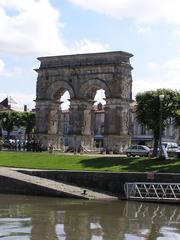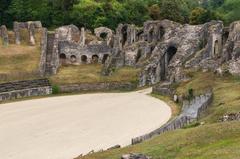
Aqueduct of Saintes: Visiting Hours, Tickets, and Historical Sites Guide
Date: 04/07/2025
Introduction
Nestled in the scenic region of southwestern France, the Aqueduct of Saintes stands as an extraordinary example of Roman engineering and urban planning. Constructed in the 1st century CE, this aqueduct supplied the ancient city of Mediolanum Santonum—now Saintes—with fresh water sourced from nearby springs. Its 17-kilometer stretch, featuring underground galleries and soaring arched bridges such as the Pont des Arcs, underscores the Romans’ mastery of hydraulic technology and their commitment to urban infrastructure. Today, the aqueduct is recognized as a Historical Monument along its entire route, reflecting its outstanding preservation and cultural value.
Visitors can explore both the outdoor remnants and, with guided tours, venture into subterranean sections that reveal original masonry and ancient water channels. The aqueduct is closely linked with other Roman sites in Saintes, including the amphitheatre, Arch of Germanicus, and Saint-Saloine Baths, offering a comprehensive glimpse into ancient city life. Most outdoor areas are freely accessible year-round, and affordable guided tours are available for those seeking a deeper understanding of this remarkable site.
For planning your visit, up-to-date details and tour bookings are available on the official Saintes Tourism website, and interactive guides can be accessed through the Audiala app. Begin your journey through history and discover where the waters of antiquity once flowed so vitally (Saintes Tourism; Ancient Engineering Marvels; OpenAgenda).
Table of Contents
- Historical Context and Roman Foundation of Saintes
- The Roman Aqueducts: Engineering Marvels of Saintes
- Aqueduct of Saintes: Visiting Hours, Tickets, and Accessibility
- Guided Tours and Visitor Tips
- Nearby Attractions and Events
- Frequently Asked Questions (FAQs)
- Visual Highlights
- Related Sites in Saintes
- Plan Your Visit and Stay Connected
Historical Context and Roman Foundation of Saintes
The origins of Saintes date to the Roman conquest of Gaul in the 1st century BCE. Established around 20 BCE as Mediolanum Santonum, the city rose to prominence as the first Roman capital of Aquitania. Its strategic location on the Charente River and major Roman roads fostered economic and administrative development. Monumental constructions, including the amphitheatre, triumphal arch, baths, and the aqueducts, exemplified the city’s significance in Roman Gaul.
The Roman Aqueducts: Engineering Marvels of Saintes
The aqueducts of Saintes exemplify Roman technological skill and urban sophistication. The earliest aqueduct, completed around 20 CE, transported water from the Font Morillon spring via the Pont des Arcs, a 160-meter-long bridge with 27 arches. Later expansions in the mid-1st century CE increased water capacity, drawing from springs up to 15 kilometers away. Archaeological discoveries indicate further enhancements into the 4th century, reflecting the city’s continued growth.
Aqueduct of Saintes: Visiting Hours, Tickets, and Accessibility
- Opening Hours: Outdoor sections of the aqueduct, including the Pont des Arcs, are accessible year-round during daylight hours. The amphitheatre and Arch of Germanicus generally open from 9:30 AM to 6:00 PM (April–September), with reduced hours in the off-season.
- Tickets: The aqueduct’s outdoor areas are free to visit. Tickets for the amphitheatre and Arch of Germanicus are typically around €5 for adults, with concessions available.
- Accessibility: Main pathways are suitable for most visitors, though some areas—especially underground sections—may pose challenges for those with limited mobility. Refer to the Saintes tourism website for detailed accessibility information.
Guided Tours and Visitor Tips
Guided tours, available through the Saintes Tourist Office, are the best way to fully appreciate the aqueduct’s history and engineering. These tours often include walking routes along the aqueduct and visits to other Roman sites.
Tips for Visitors:
- Wear comfortable walking shoes and bring water.
- The Pont des Arcs and amphitheatre are especially photogenic during golden hour.
- Combine your visit with other Roman monuments for a holistic experience.
Nearby Attractions and Events
In addition to the aqueduct, Saintes boasts a wealth of historical sites, including the Saintes Cathedral, the medieval old town, and the Saint-Saloine Baths. The city hosts cultural events and festivals throughout the year, many celebrating its Roman heritage.
Frequently Asked Questions (FAQs)
Q: Is the aqueduct open year-round?
A: Yes, the outdoor remains are accessible throughout the year during daylight hours.
Q: Are guided tours available for the aqueduct and other monuments?
A: Yes, guided tours can be booked through the Saintes Tourist Office and often include multiple Roman sites.
Q: Is there an entrance fee for the aqueduct?
A: No, outdoor sections are free to visit; some guided tours and indoor monuments may require tickets.
Q: How do I get there from the city center?
A: The Pont des Arcs is about a 20-minute walk from Saintes’ city center, with clear signage along the route.
Visual Highlights
Suggested images for your visit:
- “Pont des Arcs aqueduct in Saintes, showcasing Roman arches and limestone construction.”
- “Roman amphitheatre of Saintes during sunset.”
- “Arch of Germanicus entrance to the Roman bridge in Saintes.”
Related Sites in Saintes
Plan Your Visit and Stay Connected
For the latest updates on visiting hours, ticketing, and events, consult the official Saintes Tourism website.
Download the Audiala app for self-guided tours, interactive maps, and exclusive content about Saintes’ Roman heritage.
In-Depth: Architecture, Engineering, and Legacy
Route and Construction
The Aqueduct of Saintes stretches 17 kilometers, traversing Le Douhet, Vénérand, Fontcouverte, and Saintes (openagenda.com). Its route was precisely planned to maintain a gentle gradient, ensuring gravity-fed flow from the Vénérand springs. The aqueduct combines underground tunnels, surface channels, and above-ground arches, adapting ingeniously to the landscape (whatiswaterwebsite.com).
Hydraulic Engineering
Water intake structures at Vénérand included settling basins to improve quality (thecrazytourist.com). The Romans used tools like the chorobates and groma to achieve a precise gradient, ensuring steady flow and minimizing stagnation and erosion.
Materials and Techniques
The channels were lined with opus signinum, a waterproof mortar of lime, sand, and crushed ceramics. Arched bridges, such as the Pont des Arcs, demonstrate the Romans’ mastery of semicircular arches for spanning valleys (romanhistory.org).
Maintenance and Preservation
Vertical shafts allowed for regular cleaning and repairs. The aqueduct’s status as a protected Historical Monument has ensured ongoing conservation (openagenda.com; papersowl.com).
Cultural Impact
The aqueduct enabled the growth of Mediolanum Santonum, supporting public baths, fountains, and urban amenities. It symbolizes Roman innovation and the integration of engineering with civic and social life (artsandculture.google.com; whatiswaterwebsite.com).
Practical Visitor Information
- Location: Near Vénérand, north of Saintes, Charente-Maritime, Nouvelle-Aquitaine, France (All Andorra).
- Access: By car, bicycle, or on foot; parking available.
- Facilities: Limited on-site; amenities in Vénérand and Saintes.
- Best Time to Visit: Late spring to early autumn for optimal weather and events.
Essential Tips
- Combine your visit with other Roman and medieval sites for a full-day experience.
- Photography: Best at sunrise or sunset for dramatic lighting.
- Accessibility: Main paths are generally accessible; check in advance for underground tours.
- Pets: Allowed on a leash.
Summary
The Aqueduct of Saintes is a living testament to Roman engineering and urban planning. Its accessible remains and connection to other Roman monuments make it a compelling destination for anyone interested in history, architecture, or the scenic landscapes of southwestern France. Enhance your visit with resources from the Saintes Tourism website and the Audiala app, and immerse yourself in the enduring legacy of Roman ingenuity (Saintes Tourism; Roman History; Ancient Engineering Marvels).




